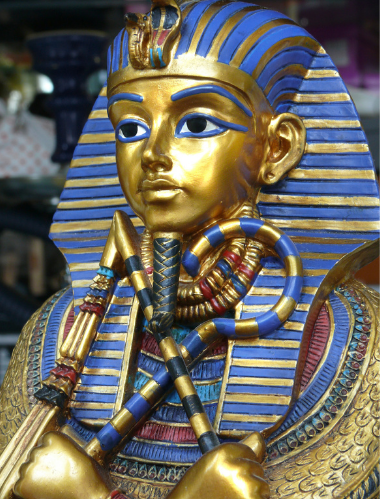
For centuries Egypt remained the world’s most advanced civilization. One of its hallmarks was an exquisite level of material culture, which included fine artisanship in the working of precious metals particularly gold. The Egyptians exploited gold-bearing quartzite and other minerals in the eastern desert and Nubia.
Around 1500 BC, Egypt was the world’s leading gold exporter. It played a significant role in the strength of Pharaohs by providing them riches unknown to the surrounding nations. This region is so rich that the gold is found in its desert sands even today. Egypt is once again in the spotlight of gold mining.
Today we are taking a look at the history of gold mining from ancient Egypt to the modern day.
Gold Mining in Ancient Egypt
In ancient times, gold was the emblem of power and divinity, which was used to adorn temples, palaces, paintings, and statues. We still get a sense of the magnificent existence of Egyptian rulers through their gold studded tombs and golden masks.
Predynastic Era (Beyond 3000 BC)
Before the kingdoms of pharaohs, Ancient Egyptians were hunters and farmers who relied on the Nile River for their livelihood. Evidence suggests that they knew of gold in the eastern desert but there is little to no evidence of gold mining in the Predynastic era.
Gold in the Era of Egyptian Pharaohs
The Egyptians regarded gold to be the skin of gods, it was both an ornament and source of wealth for rulers. For this purpose, they extensively looked for the gold resource in the empire and also traded gold from other African countries.

Ancient Egyptian rule is divided into 3 eras; Old Kingdom, New Kingdom, and Ptolemaic era.
Old Kingdom (2649-2150 BC)
The Old Kingdom was the period when Egypt was at its peak of trade and wealth. Nubia, which later became the center of gold mining, came under Egyptian domination during this time. Gold mining remained focused on alluvial deposits and surface deposits. At the end of the period, Egyptians developed new techniques such as fire setting and ore crushing to access deeper gold veins.
New Kingdom (2200 BC-1000 BC)
The first gold mine was established in Wadi Hammamat, in the eastern desert, during this era. In the following years, the focus was relocated to gold-rich areas in Nubia that now form part of Sudan. Gold mines of Bir umm el Fawakir and Wadi el-Sid in Egypt were established during the New Kingdom.
The Egyptians established new mines and sent prisoners and slaves to work in Nubia. Slaves utilized metal chisels to smash rocks, which were crushed into a powder and then washed to extract the gold. Nubia thus became a gold-mining center, and mining in the eastern desert virtually stopped.
Ptolemaic Era (300 BC-30 BC)
Following Alexander the Great’s death in 332 BC, the Ptolemaic dynasty took control of Egypt. The Greek rulers continued to extract gold from Nubia, but they also began searching for new sources of gold in the eastern desert. Greek miners re-opened numerous ancient mines and improved safety practices in mining.
According to estimates, 300 tons of gold were extracted from the eastern desert during the Ptolemaic era alone. Such an amount was very significant at that time. This gold was extensively employed in temples, monuments, and the royal treasury. Greek rulers also issued coins made of this gold.
Post-Pharaonic era
Gold extraction continued in Egypt, after the fall of the Ptolemaic empire. Arabs improved old mining techniques and invented new ways to extract gold from ore. The rotary method became the norm for gold extraction. They also discovered new gold mines in Nubia’s desert. During Arab rule, Wadi Allaqi and Wadi al-Gimal first started to produce gold.
The gold mining industry in Egypt began to deteriorate in the latter part of the 16th century. A variety of causes contributed to the decline, including a lack of investment and political upheaval throughout the region. Throughout recent history, many Egyptian gold-bearing sites remained unexploited. It is estimated that Egypt still has 70 million ounces worth of gold deposits.
Gold Mining in The Modern Era
The ancient Egyptians only mined the high-quality quartz veins, and much of the surrounding region is yet to be exploited. Modern mapping technology, exploration tools, and mining equipment can all assist in the production of commercial quantities of gold from these active alteration zones.
In 2009, a mining firm called Centamin began operating at Sukari Gold mines about 30 kilometers south of Marsa Alam, in collaboration with the Egyptian Ministry of Mineral Resources. In its first year, it produced 200,000 ounces of gold. Sukari gold mines continue to produce valuable dividends and are expected to yield 14 million ounces of gold in the coming years.
Aton Resources, a Canadian firm, has been granted a mining license for the Abu Marawat region. It was given the green light after Egypt announced the discovery of a new mine in the Eastern desert.
Since July 2021, Egypt has entered into four new deals to explore 15 new locations in the Eastern Desert. There is great potential for future gold discoveries.
